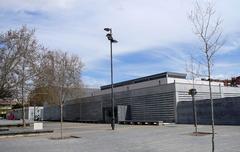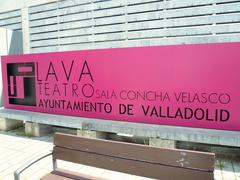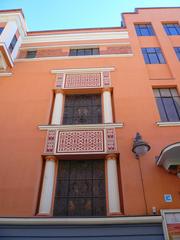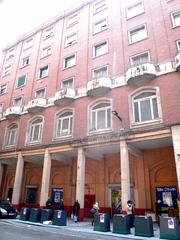Colegio de San Gregorio Valladolid: Historical Site, Visiting Hours, Tickets, and Travel Guide
Date: 15/06/2025
Introduction: Exploring a Spanish Gothic Masterpiece
The Colegio de San Gregorio, located in the heart of Valladolid, Spain, stands as a testament to the splendor of late Gothic (Isabelline) architecture and the intellectual legacy of the Spanish Renaissance. Founded in the late 15th century by Friar Alonso de Burgos, this institution began as a theological college for the Dominican Order and today houses the Museo Nacional de Escultura—one of Spain’s most important sculpture collections. This guide provides a detailed overview of the site’s history, architectural highlights, museum collections, visitor information, and travel tips to ensure you enjoy a rewarding experience at this UNESCO-worthy landmark (Smarthistory; Wikipedia).
Table of Contents
- Historical Overview
- Architectural Highlights
- Museo Nacional de Escultura: Collection and Experience
- Visitor Information
- Nearby Attractions in Valladolid
- Frequently Asked Questions (FAQ)
- Summary and Travel Tips
- References and Further Reading
Historical Overview
Foundation and Patronage
Founded between 1486 and 1488 by Friar Alonso de Burgos, the Colegio de San Gregorio was established as a premier theological college for the Dominican Order, with support from Queen Isabella I. Its establishment was confirmed by a papal bull from Pope Innocent VIII in 1487, reflecting its high religious and scholarly standing (Ecured).
The college was dedicated to Saint Gregory the Great, symbolizing its focus on wisdom and doctrinal learning. Its statutes emphasized intellectual rigor, with selective admissions for talented friars aged 19 to 28. Over time, notable figures such as Bartolomé de las Casas and Francisco de Vitoria studied here, influencing theology, law, and human rights debates in Spain and the Americas (AurelioSuarez).
Architectural Significance
The building is a masterpiece of Isabelline Gothic, blending Gothic, Renaissance, Flemish, and Mudéjar elements. The façade—attributed to Gil de Siloé—is celebrated for its exuberant ornamentation, including reliefs, coats of arms, and religious iconography that communicate the founder’s ambitions and the Catholic Monarchs’ patronage (Smarthistory; tourismattractions.net).
Key architectural features include:
- Façade: Rich in heraldic emblems, biblical figures, and symbolic motifs.
- Courtyards: Central patio with helicoidal columns and two-story arcades.
- Chapel: Houses notable retablos and funerary monuments by artists such as Juan Guas and Juan de Juni (laguiaviajera.com).
Role as Theological Center
The college quickly became a center of advanced study, hosting intellectual debates such as the Controversia de Valladolid (1550–1551), which addressed the rights of Indigenous peoples in the Americas—a milestone in international law (terranostrum.es). Its small, elite student body contributed to the development of Spanish and European theology, philosophy, and law.
Transformation into a Museum
Secularization in the 19th century led to the closure of the college. After various uses, the building was converted in 1933 into the Museo Nacional de Escultura, preserving its architectural glory while opening its doors to the public as a center for Spanish sculpture (Wikipedia).
Architectural Highlights
- Isabelline Gothic Façade: The main entrance is a tour de force of late Gothic stonework, with allegorical scenes, saints, and fantastical creatures.
- Central Courtyard: Features twisted columns and decorative medallions, epitomizing the period’s craftsmanship (spainthisway.com).
- Chapel and Funerary Monuments: Home to retablos and tombs of Alonso de Burgos, demonstrating the intersection of art and devotion.
- Plateresque Staircase: A highlight of the Gothic-Renaissance transition, with ornate balustrades (spainthisway.com).
- Recent Renovations: Modern updates by Nieto Sobejano Architects have preserved historic elements and improved accessibility (architectural-review.com).
Museo Nacional de Escultura: Collection and Experience
The museum’s collection is one of Spain’s finest, focusing on religious sculpture from the late Middle Ages through the 19th century. Highlights include:
- Polychrome Wood Sculpture: Masterpieces by Alonso Berruguete, Gregorio Fernández, and Juan de Juni (WhichMuseum).
- Altarpieces and Choir Stalls: Recovered from churches and convents, displaying the richness of Spanish religious art.
- Holy Week Traditions: During Easter, the museum’s sculptures participate in Valladolid’s famous processions (The Crazy Tourist).
- Temporary Exhibitions: Rotating displays enhance the core collection.
The museum is spread across several historic buildings, including the Palacio de Villena and Palacio del Conde de Gondomar, allowing visitors to explore a range of artistic periods and styles (Wikipedia).
Visitor Information
Opening Hours
- Colegio de San Gregorio (Museo Nacional de Escultura):
- Tuesday to Saturday: 10:00 AM – 7:00 PM
- Sundays and holidays: 10:00 AM – 2:00 PM
- Closed Mondays and select holidays (January 1, May 1, December 25) (Spain.info)
Tickets and Admission
- General Admission: €6 (may vary; check official site for updates)
- Reduced Admission: €3–€4 (students, seniors)
- Free Entry: Saturday afternoons (4:00 PM–7:30 PM), Sundays (10:00 AM–2:00 PM), and on select cultural heritage days
- Children/Residents: Free for children under 18 and Valladolid residents
- Online Purchase: Official museum website
Accessibility
- Wheelchair-accessible entrances, ramps, and elevators are available.
- Accessible restrooms and seating.
- Some historic areas may pose challenges; contact the museum for specific needs. (architectural-review.com)
Guided Tours and Events
- Guided tours in Spanish and English; advance booking recommended.
- Temporary exhibitions and cultural events.
- Audio guides and educational materials available.
Getting There
- Address: Calle Cadenas de San Gregorio, 1, 47003 Valladolid, Spain
- Transport: Walkable from Plaza Mayor; well-connected by city bus. Parking is limited—public transport is encouraged.
Nearby Attractions in Valladolid
- Convent of San Pablo: Adjacent to San Gregorio, with its own stunning façade.
- Plaza Mayor: The city’s vibrant main square, lined with cafés and shops.
- Valladolid Cathedral: A short walk away, representing the city’s religious heritage.
- Colegio de Santa Cruz: Another Renaissance college, now a university building.
- National Museum of Contemporary Sculpture: For a contrast to San Gregorio’s classical holdings.
Frequently Asked Questions (FAQ)
Q: What are the visiting hours for Colegio de San Gregorio?
A: Tuesday to Saturday: 10:00 AM–7:00 PM; Sundays and holidays: 10:00 AM–2:00 PM. Closed Mondays.
Q: How much do tickets cost?
A: General admission is €6; reduced rates available. Free entry on Saturday afternoons and Sundays.
Q: Is the museum wheelchair accessible?
A: Yes, the facility is largely accessible, but some historic areas may have limitations.
Q: Are guided tours available?
A: Yes, in multiple languages; book ahead for availability.
Q: Can I take photographs inside?
A: Photography is permitted in designated areas; please ask staff for details.
Summary and Travel Tips
The Colegio de San Gregorio is a must-see for anyone interested in Spanish history, art, or architecture. Its Isabelline Gothic façade, tranquil courtyards, and world-class sculpture collection offer a memorable journey into Spain’s Golden Age.
Travel tips:
- Arrive early to enjoy the façade in morning light.
- Combine your visit with a stroll in Valladolid’s historic center.
- Check for special exhibitions or Holy Week events.
- Download the Audiala app for interactive guides and book tours in advance.
References and Further Reading
- Smarthistory – Gil de Siloé: San Gregorio, Valladolid
- Ecured – Colegio de San Gregorio de Valladolid
- Tourism Attractions – Colegio de San Gregorio Valladolid
- Academia.edu – Reseña de El Colegio de San Gregorio de Valladolid
- Wikipedia – National Museum of Sculpture, Valladolid
- WhichMuseum – National Museum of Sculpture, Valladolid
- Terra Nostrum – Colegio de San Gregorio Museo Nacional de Escultura
- Architectural Review – Museo Nacional Colegio de San Gregorio by Nieto Sobejano
- Spain This Way – Valladolid Attractions
- The Crazy Tourist – 15 Best Things to Do in Valladolid
Discover more about Valladolid’s treasures by exploring our other articles and by using the Audiala app for your next cultural adventure. Experience the living history and artistry that make the Colegio de San Gregorio a jewel of Spanish heritage.




